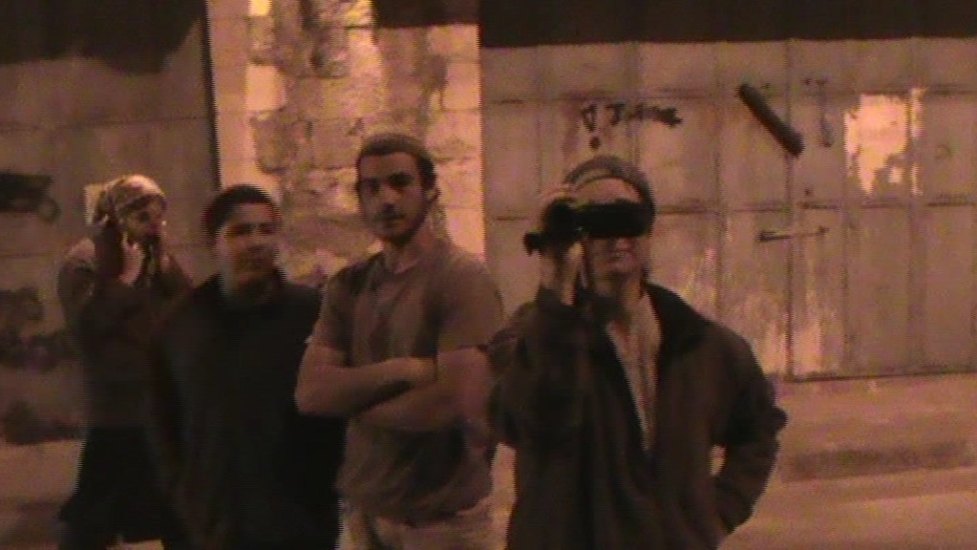“The gaze that sees is the gaze that dominates.”
—Michel Foucault, The Birth of the Clinic
In 2010, an Israeli journalist published Eden Abergil’s Facebook album, “IDF — the best time of my life,” creating a scandal. Abergil’s album contained photographs of her posing with handcuffed and blindfolded Palestinians during her time serving in the Israeli Defense Forces (IDF), a compulsory duty for all Jewish Israelis, with some exceptions. (An increasing number of leftist Jewish Israelis are refusing to serve, opting to go to military prison instead.) She poses lasciviously, puckering up and looking right into the camera, as the Palestinian detainees behind her are blind to the world, to the camera, to the image-capture. The power differences are tactile: Abergil, the Israeli, can move her body, can see, can document, and can share documentation as souvenir — as war-spoil (“You’re sexiest like that,” commented one of Abergil’s friends under the original Facebook photograph). The Palestinian detainees cannot move, cannot see, cannot document (“I wonder if he’s on Facebook! I have to tag him in the photo!” replied Abergil).
In the fallout, the Israeli Defense Forces wrote Abergil off as one exceptional, “disgraceful,” “bad apple” of a soldier. Abergil told Israeli army radio she didn’t “understand what’s wrong” with the photographs, since they were taken “out of excitement, to remember the experience. It wasn’t a political statement or any kind of statement.” I contend that it is much easier to dismiss Abergil as “stupid,” “exceptional,” or “bad” than to look — and I mean, really look, with a sincere attention to vision — at the systems and structures through which Abergil might truly claim her photos contained “nothing wrong.”
Visual evidence alone is not enough, because more is at stake in these conflicts than visuality. Believing precedes seeing, and seeing fails to alter belief
Abergil’s “nothing wrong” is comprised of blindness to the slow, suspended violence that comprises the visual acts of ordinary complicity of the Israeli occupation at the national and political levels. Perhaps this “nothing wrong” is the result of an occupation that has devoted considerable national effort to a distinctly visual erasure, obfuscation, and deletion. Taken together, these inflict at best a partitioned vision and at worst a failure to see: planting forests over ruins of Palestinian villages; supplanting Arab street and town names with Hebrew ones; creating separate and visually isolated roadways through the West Bank for Israeli citizens; creating an eight-meter tall concrete wall that literally blocks non-citizen Palestinians from sight. As others have noted, the Zionist phrase itself, “a land without a people for a people without a land,” sloganizes a deep colonialist blindness to the presence of Palestinians.
It is therefore not a stretch to look at this conflict — and many conflicts like it, such as the conflict that manifests as repeated and horrific violence against black people by U.S. police — as one that has produced an inequality of visual rights. These visual rights include rights to see and to be seen; rights to look and to surveil; rights to be out of sight (of surveillance, for instance; rights to have one’s body removed from the street and from view in a dignified amount of time); and rights to have one’s image trusted (trust, rather than subject to a “digital suspicion” through claims of photoshopping, cropping, falsification in postproduction, or simply mistrusted as in, “he was running towards the camera so had it coming”). If “the gaze that sees is the gaze that dominates,” as Foucault has written, then the seer has power over the seen. An uneven distribution of power in the realms of economics, politics, natural resources, equality, and justice within a conflict zone also reaches the realm of visuality itself.
Recently, visual studies scholars have turned toward conflict studies and proposed an examination of conflict through vision (see Gil Z. Hochberg or Ariella Azoulay, to name a few). This somewhat radical act means foregoing questions of what “really happened” in a conflict, or other such questions that assume an underlying, essential truth that can be “re-presented” through the media. Instead, a visual studies approach means asking questions of how we see a conflict, visually — in place of how visual media represent what might have “really happened.” Visual questions about a conflict include: What tools of visioning are being used in this conflict, and who or what holds them? Who can see, what can be seen, and how are they seeing or being seen? What is out of sight or hidden from the frame? What are the technologies of seeing, and who has access to them? What tensions of visioning arise, and whence?
Tensions of visioning arose in the aftermath of the Abergil affair, in which various groups chose to blur or pixelate different faces in the photographs. Right wing groups pixelated Abergil’s face, while left-wing groups pixelated the Palestinians’ faces (the original photographs were published without pixilation). Each group saw the same photograph, and separately chose to intentionally obfuscate vision itself in a battle over whose personal or ethnonational identity merited privacy, or whose personal or ethnonational identity merited freedom from humiliation. In this way, each political faction offered a partitioned vision, where one image intentionally shows only a portion of the visual field.
Political views obscure vision. Political views can also promote vision-capture, as with state-sponsored surveillance and mass imaging. Therefore, it’s not enough to talk about the visuality of a conflict alone; we must also talk about the politics of it. Much has been written about the “counter-hegemonic potential” of new technology in giving power to the repressed, especially in the wake of the Arab Spring uprisings, but this writing often lacks full consideration for the visual-political landscape. In Israel/Palestine, a camera is given to a Palestinian with the conviction that “seeing is believing,” or that visual recordings will cause change in the sociopolitical order. However, as we’ve seen over and over again in this country, even when violence against black people is captured on film, officers do not face the consequences. Diamond Reynolds’ cell phone video of Philando Castile’s death didn’t lead to Jeronimo Yanez’s conviction. Visual evidence alone is not enough, because more is at stake in these conflicts than visuality. Believing precedes seeing, and therefore seeing fails to alter belief.
Therefore, I argue we must ask questions about conflicts that weave together visuality with power: What does it mean to rely on vision to upset or reinforce power in a conflict? What causal and systemic operations link visuality to power, link power to rights? How might one employ technologies of seeing to gain a footing in a field of unequal visual rights in a conflict zone?
These are the questions that comprise spectral power: a study of visuality in conflict zones in terms of politics and rights — the “power” to tie visual actions in conflict to the political struggle for rights. In this way, I build off of Hannah Arendt’s arguments that “Being and Appearing coincide” in politics — that is, politics is intrinsically tied to visuality, and cannot be guided by an invisible force. I call this “spectral” to refer to the spectrum, in physics, which is the band of light of continuous frequencies (the rainbow) that makes up the visual field. Also to reference the specter, or ghost — the haunting that so often occurs when conflicts are visually recorded, and when recordings of violence, death, and ordinary complicity can be replayed, recirculated, relived, republished, haunting us as they search for a reckoning.
B’Tselem is an Israeli NGO that has been distributing cameras to Palestinians living in the West Bank, East Jerusalem, and the Gaza Strip — areas where tensions are high and clashes are commonplace — since 2007. It has amassed an archive of over 5,000 hours of footage, which it keeps on a handful of different servers and in rows of original magnetic tapes behind glass doors. When I began researching in the B’Tselem video archives in 2013, I had not yet been to Ramallah, Jenin, Palestinian Hebron — Israeli law forbids all of its non-enlisted citizens, myself included, from entering any Palestinian-controlled city (“Under normal circumstances only soldiers are allowed to see Palestinians,” wrote Ariel Handel in Notes on the Senses). I went to the archives to flood myself with vision that was not my own.
Jewish Israelis often refer to the Israeli/Palestinian conflict as “the situation” (hamatzav). “The situation” is not just a standard euphemism — a polite expression used in place of words that otherwise might be unpleasant. The term’s key feature is that it refers to something both present and absent at once: both a big deal, and a trifle. The phrase doesn’t just mute the valence of “Israeli/Palestinian conflict,” or change its valence entirely. Instead, “the situation” provides an opportunity for denial. (“Have you heard about the situation in the news today?” one might say; another might say, “You know, I look around me, and the situation looks good! I have a cappuccino, the sun is shining, what else do I need?”).
In this way, “the situation” closely resembles how the term euphemism itself was used by the ancient Greeks to mean “keeping a holy silence.” The silencing, absenting possibility of “the situation” allows the Israeli/Palestinian conflict to be enforced or denied at will by those in power. “The situation” is both visible and invisible. One could say, as Edward Said did in the preface to Dreams of a Nation, that “the whole history of the Palestinian struggle has to do with the desire to be visible.” One could also say that the whole history of the Israeli struggle has to do with the desire to make all pieces of the conflict invisible, including the conflict’s very name.
The deletion of footage restores the one-way hierarchy of vision to the Israeli occupiers. No footage, no vision; no vision, no power
Anthropologist Michael Taussig calls this a “public secret” — “a secret that is known to the public but which the public chooses to keep from itself through various cultural strategies and mechanisms, something that is known but cannot be articulated within the terms of governing social norms.” A public secret is about knowing what not to know, or, to borrow from Adi Kuntsman and Rebecca L. Stein, about “living with one’s complicity within violence, about participating in and sustaining social institutions of racism, incarceration, and even slavery.” In Israel/Palestine, this public secret means that Jewish Israelis have forms of social contracts that condone ethnonational racism, that contain state violence, and that suppress the conflict from view, when possible. In other words, the Israeli public suppresses the Palestinians into a state of what Gil Z. Hochberg has called public invisibility — a condition of reduced visibility caused by the removal of rights, which parallels the condition of the stateless refugee.
When I met Raed Abu a-Rmeileh in his souvenir shop in the old city of Hebron, he was wearing his B’Tselem badge around his neck, like a member of the press or a conference attendee. Abu a-Rmeileh is a volunteer filmmaker for B’Tselem, and told me that the locals call him to film whenever tensions flare — with demonstrations, arrests, detainments, or confrontations with soldiers or settlers. I had been watching a good deal of his footage lately, and had come to know his tempo of breathing.
A-Rmeileh showed me clips on his B’Tselem-issued video camera. “This was just taken yesterday,” he would say, and we would watch a violent detainment or a blocked checkpoint line. Many Palestinians will not speak to Jewish Israelis like myself out of a belief that doing so normalizes the occupier. A-Rmeileh, however, wanted me to see the injustice. In Ariella Azoulay’s The Civil Contract of Photography, the image (or video, by extension) articulates an exchange of gazes whereby the spectator animates the image, recognizes it, and is locked into a relationship of accountability to that image. Like B’Tselem as a whole, a-Rmeileh believes that seeing injustice on film can cause change.
One thing that distinguishes the Israeli-Palestinian conflict is the freedom to record. Israeli law is more lenient on recording in public than is the state of Massachusetts. In a letter from a Public Inquiries Officer, the IDF Central Command states, “filming in Judea and Samaria [the West Bank] is permitted, including filming of IDF soldiers, so long as nothing about the filming interferes with the forces’ operations or serves to collect classified information.” Moreover, the volunteers who film for B’Tselem sign an explicit legal document with the Israeli Defense Forces. Certain things are off limits to the camera’s eye, such as court proceedings, army facilities, any persons working for Israel’s internal security services (“Shabak” — similar to America’s FBI), and checkpoints. Checkpoints are a gray area, though: film too close, and one could argue you begin collecting “classified information” pertaining to security screening methodology. (Israeli police regulations flat-out prohibit filming at police checkpoints, which differ from military checkpoints). However, plenty of footage captures checkpoints from a distance.
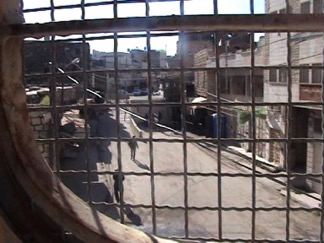
Checkpoint in Hebron seen from the window of a Palestinian home. Filmed by a B’Tselem volunteer in Hebron.
The checkpoint, more than any other site, is where “Palestinians are produced as occupied subjects,” as Hochberg has put it, or where one gaze has dominance over another. Checkpoints bring together Palestinian and Israeli eyes, in what Eyal Weizman has described as a “one-way hierarchy of vision.” Israelis are empowered with the unidirectional gaze via inspection, watchtowers, metal-detectors, and other technologies of seeing (including the visual strip search), while Palestinians are reduced to the position of displaying their bodies and IDs. If this natural order is disrupted, it is thought, catastrophe ensues: I think of a scene in Palestinian director Elia Suleiman’s film, Divine Intervention, in which the female lead (Manal Khader) walks through the Qalandia checkpoint and refuses the soldier’s orders to stop. The soldiers are left flabbergasted, and their watchtower collapses — presumably causally — as Khader walks on, unscathed.
This fantastical scene provokes a real question: Does the noncompliant Palestinian body cause an Israeli failure of vision? Normally, Palestinians at a checkpoint report averting their gaze to seem non-confrontational to the dominant Israeli eye. In the normal visual order, it is the Palestinian whose vision must fall to the ground in the containment of subjugation. But in Divine Intervention, Khader creates a reversal of this hierarchy: She looks squarely at the Israeli soldiers, even lifting her sunglasses for a long moment to meet their eyes directly.
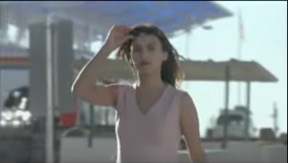
Still from Divine Intervention, directed by Elia Suleiman.
If “the gaze that sees is the gaze that dominates” (Foucault), then the Palestinian with a camera reverses the normal order of domination. Likewise, the citizen with the cell phone video of the police reverses the normal hierarchy of vision, which flows from state to people, from white to black. Not all visual reversals cause results as spectacular as Divine Intervention’s collapsing watchtower — but some do. B’Tselem footage has served as evidence in Israeli courts to release wrongfully arrested Palestinians. A-Rmeileh told me he’s traded footage for the release of detained Palestinian friends in Hebron. He told me he has agreed to delete footage, or hand over entire tapes in a “footage-for-prisoner” swap. (The IDF does not authenticate claims of this sort, but one wouldn’t expect it to: if true, the whole point of the trade of visual recordings for detainees is to remove them from public record.) The deletion of footage restores the one-way hierarchy of vision to the Israeli occupiers. No footage, no vision; no vision, no power.
The reversal of the typical one-way hierarchy of vision allows for a view into the slow violence of the Israeli occupation. Images of spectacular violence abound, such as images of wars, incursions, operations, flotilla incidents, drone operations. But this conflict also comprises what Adi Ophir and Azoulay have called “suspended violence”: the mundane and persistent type of violence that is so routine it has become almost invisible. Suspended violence occurs when Israeli soldiers are instructed to conduct night raids into homes, and simply gather, identify, count, and photograph everyone sleeping there, often as part of an effort to make the army’s “presence felt.” With a reversal of the visual hierarchy, these are the images that come into view.
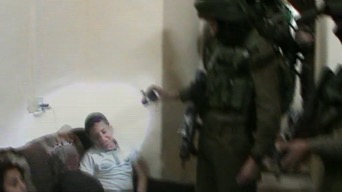
A night raid filmed by B’Tselem volunteer Imad Abu Shamsiyeh and family, Hebron.
The reversal of visual hierarchies does not come without strife. At least once, a-Rmeileh was beaten by an Israeli settler for filming in Hebron. However, other B’Tselem camerapersons report feeling a protective presence from the camera: “I used to walk down the main road and be afraid, but today I feel safer … Before we had cameras [Israeli] settlers would come almost every day, and now it only happens rarely,” said Mahmoud Dana, another Hebron-based Palestinian cameraman. To some, the camera becomes a surrogate alibi, a surrogate shield; to others, cameras become the locus of a displaced, surrogate conflict.
There are two kinds of shooting: shooting with a rifle, and shooting with a camera. “One shoots for his life, one shoots for the life of his regime” (Rabih Mroue). The B’Tselem Camera Project originally titled itself “Shooting Back”: The Israeli army shoots with rifles and the Palestinian filmmakers shoot back with cameras.
One day, following a perambulatory, association-based archive browsing that came to be my norm, I stumbled on clip titled M2U03238: a 44-second face-off between a Palestinian cameraperson named Zidan Sharbati and an Israeli settler who is — strangely — filming back. Behind this camera is a religious Jewish woman in her 30s or 40s, with three teenagers next to her, who I presume to be her children. She and Sharbati appear to be standing only two or three meters apart, each with their lens fixed on the other. The settler’s camera covers her eyes, like a black bar to preserve her anonymity. It’s night, in what I now recognize to be Hebron, and the tension between them is palpable. These two camerapersons stand in the street, locked in a recorded checkmate.
To some, the camera becomes a surrogate alibi, a surrogate shield; to others, cameras become the locus of a displaced, surrogate conflict
This image took hold of me — and I began to find more and more like it: hundreds of instances where cameras faced off against other cameras. Hundreds of instances where a Palestinian and an Israeli were each facing each other, seeing each other, almost waiting for each other. Hundreds of instances where there was a direct tension of visioning. I wondered: Who would look away first? What would each do with their footage? What was each hoping these images would prove? What would be the impact of this surveillance, and of this simultaneous, echoing counter-surveillance? And what are the implications for me, or for any viewer — the meta-spectator in the spectral fight for visual rights? This is what I call “shooting back at shooting back” — a conflict that has spread to a surrogate battle between cameras. This is a conflict over looking, seeing, being seen, and the obstruction of visual recordings.
Israelis have countered Palestinian cameras with wet substances like spit and Coke, as well as by blinding camera sensors with too much light through mirrors, and the sun. Many times, Israeli “filming” is performed in a simple attempt to obstruct the vision of the Palestinian lens. In 2011, Jewish organizations began providing cameras to Israeli settlers to film back at their Palestinian counterparts in direct response to B’Tselem’s initiative. Tazpit News Agency (TPS) offered camera-training program to Jewish settlers living in Hebron, and has since pivoted to offer summer “journalism” courses in Israel/Palestine to international Jewish college students. Other, more renegade groups have also been known to arm themselves with cameras — notably Esh Kodesh, the Israeli outpost near Shilo that is known for its “price tag” (tag mechir) revenge attacks against surrounding Palestinian villages.
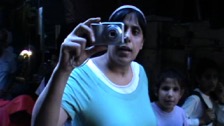
Settler filming back, filmed by B’Tselem volunteer Raed Abu a-Rmeileh, Hebron, 2012.
In the Israeli Defense Forces, soldiers “carry smartphones alongside their army-issued rifles,” and some brigades have embedded camerapersons, a practice that became common in Israel’s 2008-9 Operation Cast Lead. The IDF has its own YouTube channel to disseminate this footage, and as of this January, also released its first encrypted smartphones for official army use. Israeli visual surveillance structures extend much further, employing watchtowers, aerial photography, surveillance drones, unmanned surveillance vehicles, and brigades of female soldiers who serve as Tazpitaniot (“watchers”) that patrol live cameras from remote viewing stations.
In the B’Tselem archives, I gathered clip after clip of Israeli soldiers taking out their personal smartphones and filming back at Palestinians with cameras — a surrogate and hyperpersonal “you-film-me, so I-film-you” fight. Soldiers may not disseminate this personal footage in any way, or post it on their personal accounts. (The IDF YouTube channel disseminates highly produced videos, a small fraction of which features footage from soldier-assigned cameras or helmet-mounted GoPros.) In one archival clip, Palestinians and leftist activists in the South Hebron Hills try to film Israeli soldiers, but Israeli soldiers push out their cameras. Each side holds its camera mere inches from the other’s face, fighting to record their visual field. In the end, each camera records nothing but the other cameraperson’s nose.
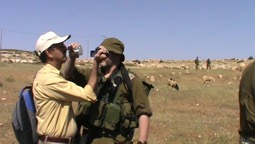
Camera fight filmed by B’Tselem volunteer Ahmad Hreni, Umm al-Amad, 2013.
I also found footage of a 2008 B’Tselem training session, where a staff member taught Palestinian boys to do the “T-Rex,” tucking their elbows into their sides and holding the camera tightly to their chests for stability. All of the footage in the B’Tselem video archive is amateur: it is blurry, shaky, tripod-free. But stable, clear, and rich images are what subvert dominance, by demanding accountability without obstruction. The stability of an image is its power. This surrogate fight between cameras is an embodied one, where the body that holds the camera is functionally integral to its gaze. A body that holds a camera functions as its temporary tripod. A tripod stabilizes a camera, just as it stabilizes weapons of artillery. When a body that holds a camera obstructs another body, it disrupts the “tripod,” thereby blocking the clarity of the camera’s image. Bodies holding cameras are not simply bodies; they are enablers of a clear gaze.
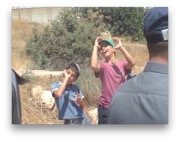
Israeli settlers mocking gestures of the Palestinian cameraperson.
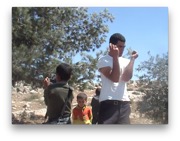
B’Tselem camera training session, teaching “T-Rex” elbow position to stabilize camera.
In a 2012 clip from Ramallah, the Palestinian filmmaker Iyad Hadad betrayed his frustration at being filmed — a frustration that must have been felt on both sides. In broken Hebrew, Hadad shouted to the soldier, “Atah Chayal!” Translation: “You’re a soldier!” The soldier shushes him. Hadad tries to finish his sentence: “You’re a soldier! Be… be… be…”
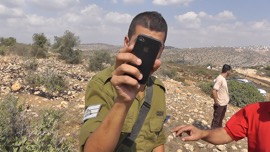
IDF soldier filming back. filmed by B’Tselem volunteer Iyad Hadad, Ramallah, 2012.
The echo of that plea stuck with me long after the clip ended. Its echoes remind me that Axon, the largest U.S. manufacturer of police body cams, was formerly the company called Taser International — maker of nonlethal electroshock weaponry that incapacitate human bodies via electrical current. Taser pivoted to cameras from weapons that stun people into stillness. What is the link between these two “smart weapons”? Is it the freeze-frame? That is, is it the frozen (incapacitated) moments that are preserved by digitization?
In zones of conflict, the site of visual capture — the camera itself — becomes a surrogate fight, and bodies that carry cameras act as temporary tripods, enabling (or disabling) a clear shot. Cameras become weaponized, like tasers. Cameras are also a first step in offering a look into one’s visual field to the world, often as a plea for justice. On its website, B’Tselem writes, optimistically, “One video, even if blurred, transmits a direct experience that cannot be ignored.” But how might this claim be reconciled with those images of Eden Abergil, which capture the same visual reality, but are understood, by many of their seers, wholly differently?
If the Palestinian camera is a move to “out” the public secret of the occupation — to make visible its invisibility — then blocking that camera is a move to reinforce the public secret. The public secret is dyadic: It’s both public and secret at once, visible and invisible, just like the euphemistic “situation.” Likewise, when the Israeli army wrote Abergil off as a “disgraceful” soldier, they reinforced the privacy of the Israeli public secret. It is Israeli common knowledge that these photos exist (“There is no IDF soldier in a combat unit that does not have at least one photograph with cuffed detainees, blindfolds on their eyes,” wrote one online commentator), but it’s a secret that only Abergil was dumb enough to expose. Her exposure broke the social contract, and the IDF restored it by dismissing her and her actions.
A public secret can clip one’s vision into a partitioned visual field — one in which a spectator can see the images, but not see the injustice; or where one can see the injustice, but fail to have mechanisms to act. Moreover, images of injustice can serve to further reinforce that injustice, as with the horrific spectacularization of lynching in America. Mamie Till revisioned her son Emmett’s image, holding an open casket ceremony for him in the most public showing of a lynching that was not intended for white supremacy and scare tactics, but instead for black justice. “I wanted the world to see what they did to my baby,” said Mamie Till. But the question remains, put most purely by Ismail Muhammad in this magazine: “Can you look at these images and honor black life?”
The answer is, it depends. It depends on what you see when you look. What you see is wrapped up in the social structures around you; what is visible to you, what is not; and what is visible to you that you’ve learned to invisiblize.
This past February, a B’Tselem volunteer filmmaker named Ahmad Ziyadah was physically detained after IDF soldiers ordered him to leave the grounds near the village of Madama and he refused. Ziyadah claims the grounds were his home. In the footage, Ziyadah first asks the soldiers not to take his camera. As the detainment becomes more violent, Ziyadah emphasizes that his video will serve as evidence (“It’s all been recorded on the camera!” he shouts three times) before finally uttering a haunting proclamation: “Your face has been seen.”
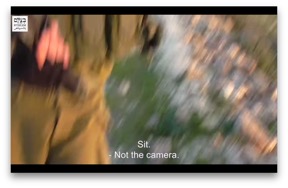
Soldiers detaining a B’Tselem volunteer, filmed by B’Tselem volunteer Ahmad Ziyadah, Madama, 2017.
The IDF did not explain the detainment or its use of force in response, but instead claimed that the filming was meant to “manufacture an incident.” IDF spokesman General Motti Almoz posted on Facebook:
There is a fundamental difference between photographing an event while it is happening and creating an event by arriving in the field with a camera … [and thus] cause friction that would not have been created otherwise …
The public secret — of Palestinian detainment by the army — is muted by claims that the camera itself provoked military action. Both the IDF and B’Tselem see the same visual reality, and understand a different result. I am left considering the visual invisibility of the occupation, and the fact that video recordings can be dismissed as provocations or disseminated as evidence, with equal measure. This is the power of the public secret.
The question then becomes, what if the freedom to record does not lead to freedom in general? What faith ought we place in spectral power?
When the Israeli Army accused B’Tselem of “manufacturing an incident,” they made use of what English teachers call the perfect continuous conditional tense: If you had not been filming, tensions would not [have] flared and you would have not been detained. This grammatical tense refers to the unfulfilled result of the action in the if-clause, and expresses this result as an unfinished action. The perfect continuous conditional is a haunting of sorts — a specter reminiscent of Barthes’ anterior future, where a photograph stings (with its punctum) because a subject will die, and has already died. The viewer is left to observe the anterior future “of which death is the stake” for the photographic subject. The anterior future produces a haunting.
Haunting is, of course, something that happens to visibility — specters, or ghosts, are things that blur lines between the invisible and the visible. A ghost haunts a person not with touch or smell, but with its sudden appearance to the eyes. A ghost is often visible to the person it is haunting, but invisible to anyone else (“What ghost?”).
Just like the specter, conflicts also produce a differentiated visual field — one with an inequality of visual rights. Perhaps the haunting is that of the watcher, who is invoked — through the mounting archive of visual materials — to grapple, revision, react, or be wounded with the punctum of an anterior future.
